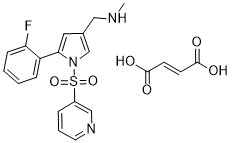This product is for research use only, not for human use. We do not sell to patients.

| Size | Price | Stock |
|---|---|---|
| 1g | $150 | Check With Us |
| 2g | $245 | Check With Us |
| 5g | $390 | Check With Us |
Cat #: V1677 CAS #: 1260141-27-2 Purity ≥ 98%
Description: Vonoprazan Fumarate (formerly TAK-438, TAK 438, trade name Takecab), the fumarate salt of Vonoprazan, is a novel, orally bioactive and potent P-CAB (potassium-competitive acid blocker) that has been approved in Janpan in 2015 for the treatment of gastroduodenal ulcer and reflux esophagitis.
Publications Citing InvivoChem Products
Product Promise

- Physicochemical and Storage Information
- Protocol
- Related Biological Data
- Stock Solution Preparation
- Quality Control Documentation
| Molecular Weight (MW) | 461.46 |
|---|---|
| Molecular Formula | C17H16FN3O2S.C4H4O4 |
| CAS No. | 1260141-27-2 |
| Storage | -20℃ for 3 years in powder formr |
| -80℃ for 2 years in solvent | |
| Solubility In Vitro | DMSO: 62 mg/mL (134.4 mM)r |
| Water:<1 mg/mLr | |
| Ethanol:<1 mg/mL | |
| Solubility In Vivo | 0.5% methylcellulose: 17 mg/mL |
| Synonyms | TAK438, Vonoprazan Fumarate, TAK-438, TAK 438, Takecab |
| Protocol | In Vitro | Vonoprazan does not inhibit Na+,K+-ATPase activity, even at concentrations 500 times higher than their IC50 values against gastric H+,K+-ATPase activity |
|---|---|---|
| In Vivo | Vonoprazan (1-4 mg/kg; p.o.) completely inhibits basal and 2-deoxy-D-glucose (2DG, 200 mg/kg s.c.)-stimulated gastric acid secretion at the 4 mg/kg dose in rats | |
| Animal model | Male 7- or 8-week-old Sprague-Dawley rat | |
| Dosages | 0.5, 1, 2, and 4 mg/kg | |
| Administration | Oral administration |
| Solvent volume to be added | Mass (the weight of a compound) | |||
|---|---|---|---|---|
| Mother liquor concentration | 1mg | 5mg | 10mg | 20mg |
| 1mM | 2.1670 mL | 10.8352 mL | 21.6704 mL | 43.3407 mL |
| 5mM | 0.4334 mL | 2.1670 mL | 4.3341 mL | 8.6681 mL |
| 10mM | 0.2167 mL | 1.0835 mL | 2.1670 mL | 4.3341 mL |
| 20mM | 0.1084 mL | 0.5418 mL | 1.0835 mL | 2.1670 mL |
This equation is commonly abbreviated as: C1 V1 = C2 V2
- (1) Please be sure that the solution is clear before the addition of next solvent. Dissolution methods like vortex, ultrasound or warming and heat may be used to aid dissolving.
- (2) Be sure to add the solvent(s) in order.




































